WHAT'S NEW:
BACKGROUND:
Mission
Project Description
Cruise Plans:
Participants
Technology (ROV, ships, etc.)
Future Plans
Results:
1998 NeMO Cruise
Axial 1998 "Eruption"
Logbook
July 8, 1999
July 8, 1999
Contents:
- News from Thompson
- Participant Perspective
- Logbook from Teacher at Sea
- Question/Answer from shore to sea
Thompson Science Report
Science Report - Thursday, July 8
Ships Location: 46 03.8/129 57.7
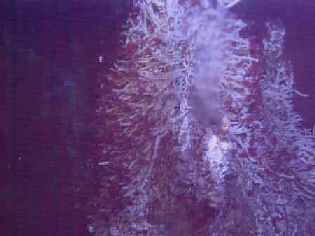 CASM vent with lush tubeworms and hydrothermal fluid venting from a chimney. |
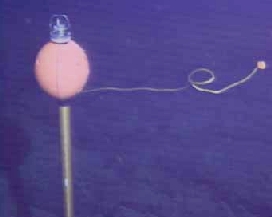 Later in dive 497, ROPOS moved further north along Axials north rift zone
to where four extensometer instruments were deployed last year. (photo left) These
instruments have measured the distance across the rift zone once a day
since then to look for changes related to magma movements under the
volcano. ROPOS had to return to the surface briefly during this
operation, but then returned to finish the job on dive 498. ROPOS found
each instrument on the bottom and moved each one to the
elevator mooring,
then released the mooring from its anchor so that it could recovered at
the surface by the ship. We plan to download the data from the
instruments, refurbish them, and then deploy them again for another year
deployment.
Later in dive 497, ROPOS moved further north along Axials north rift zone
to where four extensometer instruments were deployed last year. (photo left) These
instruments have measured the distance across the rift zone once a day
since then to look for changes related to magma movements under the
volcano. ROPOS had to return to the surface briefly during this
operation, but then returned to finish the job on dive 498. ROPOS found
each instrument on the bottom and moved each one to the
elevator mooring,
then released the mooring from its anchor so that it could recovered at
the surface by the ship. We plan to download the data from the
instruments, refurbish them, and then deploy them again for another year
deployment.
Listing of all Science News postings
Life at Sea: Participant Perspective
Leigh Evans
OSU/NOAA Vents Program
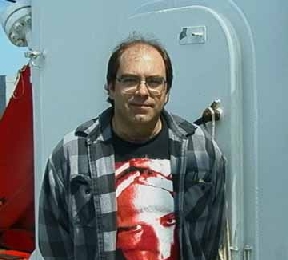 I'm on this
expedition to sample the fluids which emerge from vents and separate the
gases from them. These gases are sealed in glass ampoules for a number
of chemical analyses which will be done in laboratories on land. Aside
from that I test variations in the methods of sampling the vents.
I'm on this
expedition to sample the fluids which emerge from vents and separate the
gases from them. These gases are sealed in glass ampoules for a number
of chemical analyses which will be done in laboratories on land. Aside
from that I test variations in the methods of sampling the vents.
One of the analyses which I will be personally involved in performing is that of the helium isotopes, He3 and He4, in vent fluids. This is a gauge of the input of gases from the earth's magma into the vent system. The data are also used in comparison to other analyses of the vents such as the concentrations of iron or the amount of heat present. Sampling over a variation in geography and over time might tell us about increases or decreases in the volcano's activity, or its activity in a particular location. Other labs will analyze these samples for hydrogen and methane.
Listing of all Perspectives postings
Teacher At Sea Logbook
Teachers Log #18 7/8/99
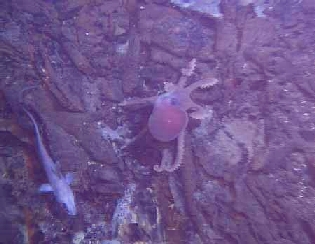 Octopus and rattail fish at the CASM vent site. |
When hydrothermal vents were first discovered in the late 70s near the Galapagos Islands, the deep ocean floor was believed to be desert-like. We now know that there is a wide diversity of life in these areas and have gained a better understanding of the interactions between the geology, chemistry and biology in deepsea environemnts, including hydrothermal vents.
Life at the vent site is intimately connected to the vent fluid. (see
diagram below, click for full size) As
seawater seeps through the porous crust of the seafloor, it is heated and
reacts with the chemicals in the rock. The heat is believed to come from a
magma chamber within the ocean crust. This superheated water rises rapidly
through the crust, seeking a way to the surface. This is what we refer to
as hydrothermal vent fluid.
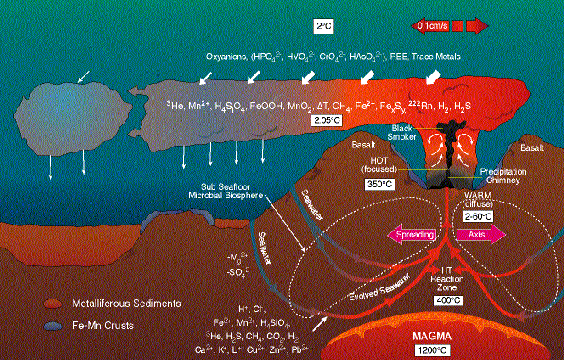
Most of the
microbes (bacteria and archea)
that exist here are referred to as hyperthermophiles because they exist in
an environment that is above 80 degrees Celsius (about 180 degrees
Farenheit) and probably anoxic (without oxygen). Factors such as space,
nutrients and temperature are important limiting factors of this area, but
have yet to be specifically determined. Within the vents and under the
seafloor surface, it is possible that subsurface microenvironments exist.
How many, what kind and how deep they go is still a mystery. As with all
vent microbes, they rely on chemosynthesis as
their source of energy rather than photosynthesis (remember, no sunlight -
no photosynthesis). (Chemosynthesis uses the oxidation of sulphide from
the vents rather than sunlight to create energy.) It is unknown just what
role the subsurface plays in the development of the surface ecosystem.
Many believe there is a definite connection. But we do know that the
microbes are the basis for the food web in this mysterious ecosystem.
Tomorrow we'll finish this discussion on the hydrothermal vent ecosystem
with special attention on the macrofauna (multicellular animals).
Bye for now.
Logbook of all Teacher At Sea postings
Questions & Answers
(oar.pmel.vents.webmaster@noaa.gov)